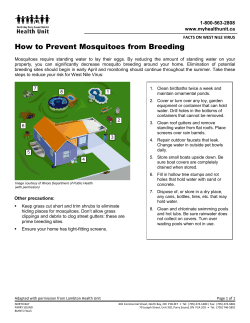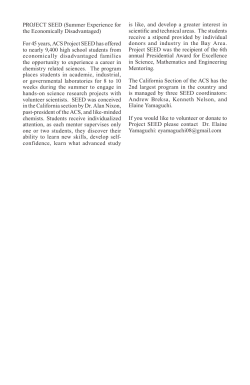
Peter Ruckenbauer - Climate change
Climatic change: callenge for training of applied scientists Symposium and Training course V. Breeding new varieties of oil seedpumpkins in Austria Peter Ruckenbauer Institute of Agronomy and Plant Breeding,Vienna /Austria Ölkürbis Evolution Cultural history Botany Developmental procedure Genetic background Breeding systems Resistance breeding ZYMV-resistance Varieties Harvesting procedure Summary Oil-seed pumpkin areas in Austria 1997 -2002 : 10 - 15 000 hectares 2003 : 15 500 2004 : 12 500 2005 : 16 000 2006 : 16 400 2007 : 17 800 2008 : 16 300 2009 : 19 000 2010 : 26 500 Oil-seed pumpkins Cucurbita pepo (2n = 40 Chromosomes, diploid) Evolution and cultural history Derived from the New World (Central-america), some species (C. maxima, C. moschata) are present, intercrosses are feaseable Multiple utilization: oil, fruit as vegetable (Zucchini etc.), dried fruits for decoration and drinking or storing purposes Styrian Oil Pumpkin: Hull-less (delete mutation), therefor specific high oil content.Utilization as an oil crop known sinced the 19th century. hulled (Quelle: Vollmann & Rajcan, 2009) - “dehulled” hulled (a), partly lignified (b, c), hull-less (d) Histology of the seed coat: Caused by delete mutation (therefore is the thin seed coat is not lignified and the outer layers are collapsed) (Quelle: Lelley et al., 2009) C. pepo - types (Paris et al., 2009) Genetic diversity between 103 Cucurbita pepo - Genotypes Evaluated by SSR-markers Genetic Diversity Name pep5 pep6 pep2 pep3 pep4 pep1 max4 max5 max2 max3 max1 max6 mos5 mos6 mos4 mos3 mos2 mos1 s s v v s v hun fr chi jap usa mon pr pr pr por usa nig Num 5 6 2 3 4 1 10 11 8 9 7 12 17 18 16 15 14 13 Rescaled Distance Cluster Combine 0 5 10 15 20 25 +---------+---------+---------+---------+---------+ Genetic diversity between 18 Cucurbita-Genotypes based upon RAPD-markers Genetic diversity In Austria, all cultivated varieties of oil see pumpkins are characterized by their hull-less seed coat and the green seed colour (founder effect).Therefore the genetic base of all our derived varieties is rather very narrow…. Practical consequences: high genetic vulnerability…. All varieties in the past have been susceptible for ZYMV ( Zuccini yellow mosaic virus ) Breeding goals and activities: Intercrosses with different pumpkin species to increase the genetic diversity ,followed by reselection for hull-less seed characters and adapted fruit types ! Oil seed pumpkin Botany Fam. Cucurbitaceae, frost intolerance, Fruit type :berry male and female flowers monoecious Sexual reproduction Self- and open pollination (by insects), inbreeding depression and heterosis visible Female and male pumpkin flowers (Monoecious) Male and female flower types of pumpkins Genetic characters desireable Hull-less types are monogenic inherited: but different modification were observed,Xenia are possible. Resistence: Monogenic resistance against the Zuccini yellow mosaic virus is transferable from Zuccini-types Molecular markers : Utilized to improve the genetic variability and resistance characters mainly for virus diseases. Hull-less pumpkin seeds Hulled pumpkin seeds Passport of the ZYMV: Family : POTIVIRIDAE Tribe : POTIVIRUS Shape : flexible bar – form Size :750 nm,12 nm diameter Genom: one +RNA strand,10.ooo nucleotids Transcription product: on big polyprotein (346 kD) Transfer : aphids, seeds, mechanically Aphid transfer: non persistant Oil seed pumpkins Breeding and breeding goals Population breeding up to 2002,now only Hybrid breeding performed Breeding for quality : High oil content >50 %, hull-less seed, green seed colour,seed type and High content of tocopherol Breeding for resistance: Zuccini yellow mosaic virus, Erysiphe ssp., Fruit rottening Breeding for agronomic characters: Yield, dwarf types with short wines,early ripening performance Pumpkin fruit diseased with ZYMV Prevention procedures against ZYMV -virus free seeds -removal of diseased plants -aphid protection -spraying non toxic oils -reflectory plastic ( mulch ) cover -cultivation under UV absorbing covers -cross protection -resistance breeding Breeding goals for ZYMV-resistance Search for new sources of resistance Crosses between Austrian hull-less varieties and tolerant or resistant genotypes Backcross procedures to maintain oil seed productivity and quality + resistance character Development of molecular markers for MAS Sources of resistance against ZYMV Cucurbita pepo L. - no resistance detected Cucurbita moschata L. - described resistance genes Cucurbita maxima L. - resistance presumed Resistance donors: Solar Medina Nigerian Local What are molecular markers? X AA Cross AA Backcross X aa F1 (Aa) BC1 F1 Population Second backcross AA X Selbstung AA Aa Aa aa AA AA AA AA AA AA AA Aa Aa aa Ein Virusinfektionstest von je 10 BC2F3 Pflanzen der BC2F2 Pflanzen identifiziert die heterozygoten BC2F2 Pflanzen, diese werden erneut geselbstet AA Aa Aa aa AA Aa Aa aa Selbstung AA Aa AA Aa Aa aa Aa aa oil-pumpkin zucchini BC1F1 BC1F2 Locus for resistance and for marker First disease symptoms with ZYMV Breeding strategies for resistance against ZYMV in oil seed pumpkins: RAPD markers for tolerant and susceptible plants (LELLEY, 2002) Marker aided selection procedures Bacterial rottening of pumpkin fruit solved by intercrossing (C.maxima) Pumpkin oil quality characters • Typical green oil colour caused by Chlorophyll and Phaeophytin (Chl.degradation product) • Linolic acid (C 18:2) as main fatty acid • Big differences in vitamin E –content • (Tocopherol ) within various oil-seed pumpkin breeding material and hybrids Oil-seed pumpkins Old variety types Gleisdorfer Ölkürbis, Sepp, Markant (v.l.) Present oil seed pumpkin varieties in Austria (Quelle: Österr. Sortenliste, AGES 2010) Testing results: fruit weight and seed % (Quelle: Neubauer et al., 2010) Thank you for your attention !
© Copyright 2025









